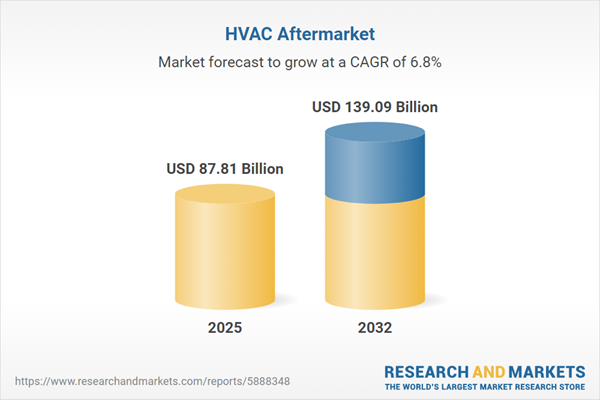Speak directly to the analyst to clarify any post sales queries you may have.
Senior leaders in the HVAC aftermarket are navigating a landscape marked by shifting regulations, advancing technology, and increasing demand for sustainable solutions. As the sector rapidly evolves, organizations agile in their strategic direction maintain strong competitive positioning and are better equipped to serve changing customer needs.
Market Snapshot: HVAC Aftermarket Market Size and Growth
The global HVAC aftermarket market reached a value of USD 82.09 billion, with projections indicating it will rise to USD 87.81 billion by 2025 and continue expanding at a compound annual growth rate (CAGR) of 6.81 percent through 2032. This upward trend is driven by sustained modernization efforts in commercial, industrial, and residential sectors, alongside a growing commitment to decarbonization. Accelerating digitalization empowers suppliers and service providers to address evolving operational challenges, streamline workflows, and improve customer experiences. Both original equipment manufacturers and independent vendors are focused on adapting their services, developing innovative solutions, and pursuing greater operational efficiency across every segment of the HVAC aftermarket.
Scope & Segmentation in the HVAC Aftermarket
In-depth segmentation is essential for strategic planning, investment targeting, and compliance alignment in the complex HVAC aftermarket. Understanding the nuances within each segment allows organizations to tailor solutions effectively and maximize their market impact. The market can be segmented by the following key dimensions:
- Service Types: Consulting, engineering, system design, installation, energy audits, maintenance, repairs, retrofits, and equipment replacement all contribute to the ongoing performance, reliability, and lifespan of HVAC systems.
- Distribution Channels: E-commerce platforms, digital marketplaces, OEM channels, repair services, distributors, and wholesalers each offer flexible purchasing arrangements, improving responsiveness and efficiency in procurement and delivery.
- End User Segments: Commercial operators in healthcare, education, hospitality, and retail, as well as industrial entities in energy, pharmaceuticals, and chemicals, along with residential property owners, each bring unique technical and operational demands to the market landscape.
- Product Types: Air conditioners, high-efficiency boilers, ductwork, ventilation systems, furnaces, heat pumps, building management platforms, IoT sensors, programmable thermostats, and control valves enable advanced monitoring as well as enhanced operational control.
- Regional Coverage: The Americas, Europe, Middle East, Africa, and Asia-Pacific represent core regions, each shaped by distinct regulations and buyer preferences. Prominent influence is exerted by countries such as the United States, Germany, China, and India, guiding broader market trends.
- Key Companies Analyzed: Carrier Global Corporation, Daikin Industries, Trane Technologies, Johnson Controls, Emerson Electric, Lennox International, Rheem Manufacturing, Honeywell, Mitsubishi Electric, and Robert Bosch GmbH are notable for their innovative offerings and adaptive service models.
Key Takeaways for Senior Decision-Makers
- Integrating remote monitoring and predictive analytics strengthens asset management strategies and minimizes downtime for clients with diverse requirements.
- Heightened environmental regulations have accelerated the focus on sustainable HVAC solutions, influencing investment decision-making and operational compliance procedures.
- The rise of digital procurement channels, combined with established distributor networks, enables organizations to respond more quickly to market dynamics and customer expectations.
- Ongoing workforce development—aligned with the adoption of advanced technologies—drives organizational flexibility, supporting adaptation to evolving industry standards.
- Collaborative ventures with research bodies foster innovation in products and services, ensuring alignment with both regulatory shifts and nuanced operational needs of end users.
- Shifting service models enable market participants to address changing benchmarks and maintain resilience in a dynamic competitive landscape.
Tariff Impact: Supply Chain and Cost Dynamics
U.S. tariff adjustments have led HVAC aftermarket suppliers to diversify sourcing strategies and expand investment in regional manufacturing capabilities. These shifts support business continuity by reducing procurement risks and increasing supply chain reliability. The application of data-driven management practices further supports cost flexibility and on-time delivery, while maintaining compliance and operational standards.
Methodology & Data Sources
This market analysis draws from interviews with executives across service, manufacturing, and distribution roles. Supplementary insights are anchored by regulatory documents, technical white papers, patent filings, and audited financial data, collectively ensuring a robust foundation for benchmarking and decision support.
Why This Report Matters for HVAC Aftermarket Leaders
- Offers actionable insights for anticipating sector shifts and responding to evolving regulatory demands and customer expectations with confidence.
- Enables improvements in digital infrastructure, reinforces supply chain strength, and supports the development of workforce competencies necessary for long-term success.
- Empowers leaders to maintain resilient, strategically positioned organizations amid ongoing change in regional and global markets.
Conclusion
Strategic market intelligence and reliable data support senior leaders in navigating transformation, developing forward-looking strategies, and maintaining agility in a competitive HVAC aftermarket environment.
Additional Product Information:
- Purchase of this report includes 1 year online access with quarterly updates.
- This report can be updated on request. Please contact our Customer Experience team using the Ask a Question widget on our website.
Table of Contents
3. Executive Summary
4. Market Overview
7. Cumulative Impact of Artificial Intelligence 2025
Companies Mentioned
The companies profiled in this HVAC Aftermarket report include:- Carrier Global Corporation
- Trane Technologies PLC
- Daikin Industries, Ltd.
- Johnson Controls International PLC
- Lennox International Inc.
- Rheem Manufacturing Company
- Emerson Electric Co.
- Honeywell International Inc.
- Mitsubishi Electric Corporation
- Robert Bosch GmbH
Table Information
| Report Attribute | Details |
|---|---|
| No. of Pages | 190 |
| Published | November 2025 |
| Forecast Period | 2025 - 2032 |
| Estimated Market Value ( USD | $ 87.81 Billion |
| Forecasted Market Value ( USD | $ 139.09 Billion |
| Compound Annual Growth Rate | 6.8% |
| Regions Covered | Global |
| No. of Companies Mentioned | 11 |









